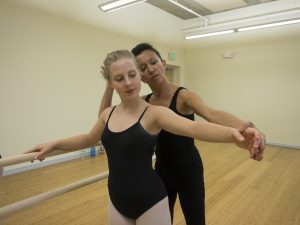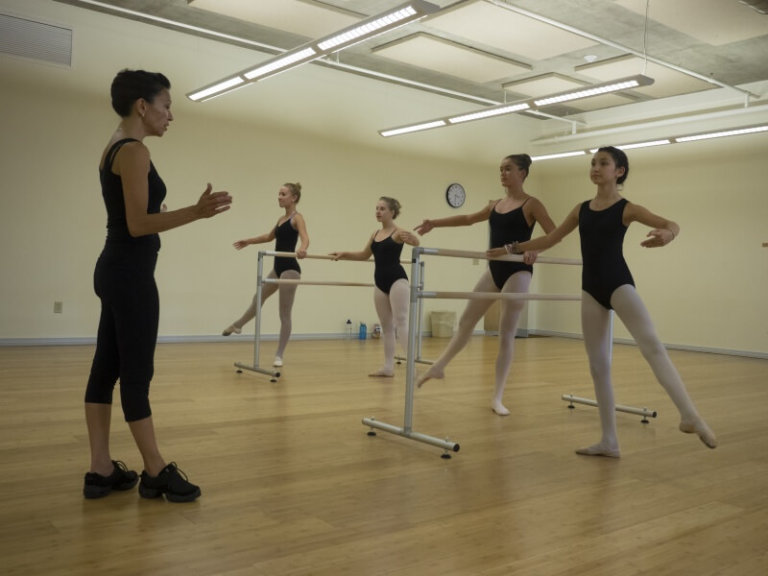
As the Dance Ensemble of Colorado Academy prepares for its February performance, In Concert ‘18, I am reminded of how this fledgling company came into being last year as a determined group of passionate young artists who answered my call. There was no tradition of dance at CA. I could offer no promises, save the one that I would strive to teach them with integrity and provide a progressive and inclusive dance experience. The call was, will you dance for me? And they answered—yes we will.
I have been thinking a lot lately about what it means to answer a call as a young artist, and the breath of its significance in a student’s education. Certainly it suggests more than simply trying out something new. It includes being committed to following a summons through fruition without the guarantee of outcome or of how your efforts might be received. It stretches students to be responsible for carving a path that is yet unseen, and in so doing, begin to achieve artistic literacy.
This notion of achieving a literacy beyond the literal meaning of the term is hardly a new concept. Educational standards speak to social, physical and mathematical literacy to name a few, and while there are many takes on artistic literacy, they all seem to speak more to students inferring meaning out of a given artistic work, their own or of others, rather than pushing the concept of literacy to seeing students as originators, not only of their own creations, but also of a way of study or an experience that begs for a prototype.
As students now prepare for the second annual 24 Hour Play Project, I am reminded of last year’s project which was one such event. On a chilly Friday afternoon, a group of 28 students gathered to receive assignments for what would be a marathon Saturday. One week previous, 5 writers received packets containing an image from our advanced photography students, a literary quote, and the breakdown of characters for whom they were to write, i.e. two females, two males/one female, and so on. The quotes and photos were to serve as inspiration only rather than be a literal directive for the writing of their 3 to 5-minute plays. The enthusiasm in the theater was palpable. Writers and directors met their assigned actors and after a first read through, they were told to cast the plays and hold a brief production meeting about costumes, props, and set needs for once they walked into the theater the following morning, they were going to be there all day, straight through production. Writers and directors went home to work on scripts, actors to learn lines, and the crew pulled props and readied sound and lighting. When they arrived at 9 a.m. Saturday morning they were eager to get started because the one given was that this day had to end in a complete production of their making—no second thoughts, no excuses. There were no extensions, no deciding to wait for inspiration, no time outs. They had one task and one task only, and that was, as this pop-up theater company, to make these original scripts come alive and hang together as a single and unified production for an audience that very same evening.
After a vigorous ensemble warm up, the students broke into groups a throughout the theater, rotating so that each cast was able to rehearse on the stage at least once that morning. They broke for lunch and gathered for a showing of works in progress to gather feedback and insight from their teachers and peers. This was followed by more rehearsal until the reckoning hour of 4:00p.m. when all casts came to roost in the theater for a tech rehearsal and two full runs which included setting music, sound, lights, projections, and scene changes. They also produced their own program, ate dinner at 6:00p.m. and welcomed an audience of family, teachers and peers at 7:00p.m. The excitement was electric. They had been working for ten hours and yet, if you asked them, they would say they had no sense of that much time passing. Their audience sat with happy anticipation for they were about to see something original, something completely new—something that did not exist when they awoke that morning. How often do any of us get to do that? And in the end, it was not about the perfection of each performance, or about who wrote or directed the better scene. There was no competition, no awards, and, most importantly, no grades or credit connected to the project. They participated, as one student told me, “because it is fun!” This day was about the “doing,” about allowing students to work towards artistic fluency and to achieve a literacy that was so layered and complex it defied the singularity of definition, mainly because it took in so much in terms of skill, thought, immediate problem solving, aesthetics, and laser focused hard work and joy. They celebrated the very art of making art, and, like all theater, it was unique and momentary. It was exhilarating for all involved and begs the question, what could you do in 24 hours?
There are many examples of artistic literacy across campus and across our divisions. On Grandparents’ Day, our 4th and 5th graders performed a choral work of two upbeat winter songs sung individually and then in counterpoint to each other. This was not a common piece of music for these young people. It was challenging, but they found the opportunity exciting and answered the call, genuinely listening to each other on stage, depending upon one another and upon their teacher conducting them. They were masters of their own universe singing for their grandparents and later for the entire student body later that afternoon. They felt the uniqueness of their endeavor and they were thrilled with their own cleverness, and rightly so.
Soon you will be seeing the gallery walls of the Ponzio Art Center filled with the original work of our Portfolio students as they strive to curate gallery shows which express their individuality as as young artists. Also, coming up on February 26 and 27 are performances of the Middle School and Upper School Band Combos and Choirs in concert together for the first time as each group grows in literacy, not only in terms of musical texts they were given to study, but also in reference to what it means to work in full artistic inclusion and create the sound of a unique recital together. If you join the dance company for In Concert ‘18 on February 23 and 24, you will see a range of choreography including senior pieces that will both fascinate and move you to wonder at the power of dance as an art form, not to mention the rich and genuine perspectives of these young artists. May they be an inspiration to all of us who seek to become more fluent, more literate in art, whatever way we choose to participate. And when we are enticed by a challenge, when we are sounded the call, may we all stand up and answer—yes we will.
